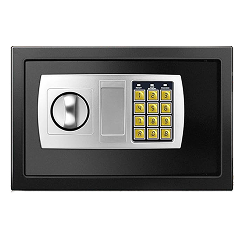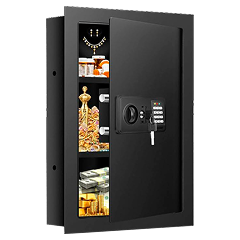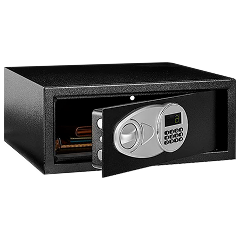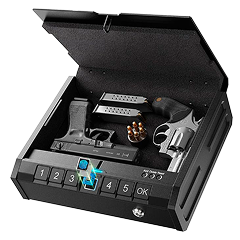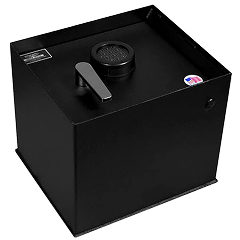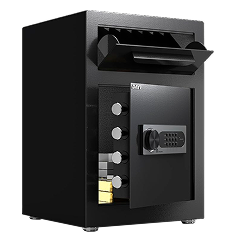After owning two smaller safes for several years, a traditional combination lock model and a portable fire safe, I started researching wall safes when I realized I needed something more discreet and permanent for my important documents.
My current safes work fine, but they’re obvious targets sitting in a closet, and the 80-pound combination safe isn’t exactly theft-proof if someone has enough time. Wall safes let you hide valuables completely behind artwork or furniture.
You’ve got three main differences with wall safes compared to regular ones: they bolt into wall studs, you can actually hide them, and you’ll trade some fire protection for that concealment.
This guide covers what actually matters when buying one: how deep your wall needs to be, what mounting looks like, and picking the right lock type. I put this together to fill in the specific details you won’t find in general safe guides.
Understanding Wall Safe Security Ratings
Manufacturers throw around security terms that sound great but often mean nothing; the rating system is a mess.
Residential Security Container (RSC) Ratings
RSC certification means the safe survived a standardized attack test using common hand tools and pry bars for five minutes, which sounds short, but burglars want to be in and out quickly.
UL-listed RSC safes consistently outperformed unrated models in my research, and the testing actually mimics real break-in attempts instead of made-up scenarios. RSC testing targets residential threats like hand tools and pry bars rather than the advanced attacks that commercial ratings handle.
Third-Party Certifications
I skip any safe with marketing fluff like “steel construction” or “security-rated” unless there’s an actual UL certification number I can verify. Companies make wild claims about security, but UL actually tests safes and publishes results.
Comparing specs side by side, safes with real UL ratings had thicker steel, better locks, and stronger mounting systems compared to those banking on fancy marketing language.
Wall Mounting Security Impact
Mounting a safe in the wall changes its security profile compared to floor models because thieves can’t attack it from all angles or carry it away. Your mounting job becomes part of the security, though.
Mess up the anchoring, and a wall safe gets pried out easier than broken into. Wall cavities limit body thickness too, so these safes focus on door security and locks instead of trying to match the steel thickness of big floor units.
Recess Depth and Mounting Requirements
Getting measurements wrong will either leave you with a safe sticking out of your wall or force you into major construction work you didn’t plan for. Standard interior walls with 2×4 framing give you about 3.5 inches of depth, but wall safes typically need between 3 and 6 inches, depending on their capacity and fire rating.
I’ve seen too many people get excited about a particular safe model only to discover their wall won’t accommodate it without removing drywall on both sides or hitting electrical lines. The depth requirement isn’t just about the safe body.
You also need space for mounting hardware and any insulation materials. Fire-rated wall safes tend to be deeper because of insulation layers, while basic security models can often fit in standard wall cavities.
Key mounting considerations:
- Standard 2×4 walls: 3.5″ maximum depth, suitable for basic security safes only
- 2×6 construction: 5.5″ depth allows for fire-rated models
- Masonry/concrete walls: Custom cutting required, professional installation recommended
- Load-bearing walls: Structural engineer consultation needed before cutting
- Electrical/plumbing conflicts: Always check for utilities before cutting
- Stud spacing: Safes are designed for 16″ on-center framing, some accommodate 24″ spacing
- Anchoring hardware: Heavy-duty lag bolts into studs minimum; some models require through-bolts
Lock Type Trade-offs for Wall Safes
Pick the wrong lock, and you’ll cut into your wall again when it fails. I’ve dealt with my traditional combination lock for years and appreciate that mechanical locks don’t need batteries or worry about electronics dying, though they’re definitely slower when you need quick access.
Lock Type Comparison for Wall Safes
Capacity and Organization Features
Think about storage space differently with wall safes. You’re stuck with whatever depth your wall allows. Most run between 0.3 and 2.0 cubic feet. Sounds tiny, right? But when I look at what actually needs hiding, like documents, jewelry, some cash, it’s plenty.
My little fire safe is half a cubic foot and holds our passports, birth certificates, insurance stuff, and jewelry just fine.
You can’t dump everything in and sort through it later, like with bigger safes. Door pockets keep small items from vanishing into corners, while adjustable shelves work for both folders and jewelry boxes. Fire protection maxes out around 30-60 minutes compared to 1-2 hours on larger units, though that’s usually fine since most house fires get a firefighter response within 30 minutes.
Key capacity considerations:
- Document storage: Legal-size folders need at least 14″ width, letter-size fits in 12″
- Jewelry organization: Look for felt-lined compartments or removable trays
- Mixed storage: Adjustable shelving accommodates both flat documents and small boxes
- Door organizers: Pockets and clips maximize space for frequently accessed items
- Depth limitations: Fire-rated models sacrifice interior space for insulation thickness
Door Swing and Keypad Orientation
Door swing direction matters way more with wall safes since you can’t rotate them like portable models. Once you install it, you’re locked into that orientation. This becomes an issue when mounting in corners or near furniture, where the wrong swing hits obstructions or makes access awkward.
You can get left or right hinges, and some models have reversible doors, but plan this before cutting the hole. Keypad placement varies. Some sit on the door, others mount to the side, and a few rotate after installation.
Those recessed door designs boost pry resistance, though the keypad ends up deeper in the wall and might be awkward to reach based on your mounting spot and furniture.
Mistakes to Avoid
Installation horror stories usually trace back to four planning mistakes that happen before you even buy the safe.
- Insufficient mounting depth: Buying a safe that doesn’t fit your wall without major construction; measure actual wall depth and factor in mounting hardware before falling for any particular model.
- Choosing too small for future needs: Starting with barely enough space guarantees you’ll outgrow it fast, and upgrading means cutting another hole or major surgery.
- Skipping wall structure verification: Assuming your wall can handle a loaded safe without checking for proper studs and utilities leads to problems.
- Cheap anchoring hardware: Substituting random bolts for the specified mounting system defeats the purpose of buying a decent safe.
Budget and Long-Term Value
Prices vary wildly on wall safes, so understanding what you’re actually paying for saves money and prevents buying junk.
Price Ranges and What You Get
Basic models without fire protection run $100-$200 and give you steel construction with a simple lock, but they’re basically metal boxes that stop casual snooping rather than real theft attempts.
The $300-$600 sweet spot gets you RSC-rated safes with thicker steel, better locks, and often fire protection, where I’d focus for home use. Above $600 pays for premium stuff like extended fire ratings, biometric locks, or commercial features that homes don’t really need.
Professional Installation Costs
Expect to pay $200-$500 for professional installation based on your wall type and local going rates, assuming you’re not handy with electrical work and wall cutting. This cost usually makes sense. I’ve seen DIY disasters that cost way more than just hiring someone, plus warranties often require proper mounting. Installers show up with proper tools for clean openings and know how to deal with unexpected wiring or plumbing.
Long-Term Value and Warranty
Good wall safes last for decades without much fuss, so you’re spreading that upfront cost over many years. Solid manufacturers back mechanical components for 1-3 years and fire protection for life, but botched installation kills most warranties. Real value comes from not worrying about your stuff, plus these don’t go obsolete like electronics.
Key Priorities for Choosing a Wall Safe
Stick to basics instead of falling for shiny features or sales pitches.
- Look for real security ratings, like actual UL numbers you can verify, not empty phrases like “security-rated” or “bank-quality.”
- Check that the mounting works with your wall, and choose a lock based on how much security you need versus how often you’ll open it. Buy bigger than you think you need, since expanding later means construction headaches.
- You want a safe that disappears into your wall and works reliably for decades while protecting what matters to you. The best ones get installed once and forgotten until you need them.
- Invest in solid construction, proper installation, and realistic capacity planning upfront.
- Skip fancy extras if they compromise basics, and remember that a good wall safe becomes permanent security infrastructure, not another gadget needing attention.


